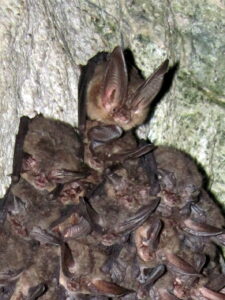Virginia Big-eared Bat 
Scientific Name: Corynorhinus townsendii virginianus
Description.
Virginia big-eared bats are medium-sized, brown bats best known for their large ears, which are typically more than 25 mm in length. Their ears are about one-third the length of their bodies, which range between 90 and 115 mm. Their nickname, “ram eared bats,” comes from the way their ears look when rolled down across the back of the head during flight. These bats weigh 5 to 13 grams and have a wingspan range of 297 to 320 mm.
Distribution.
Townsend’s big-eared bat has a large range stretching across the western US from southern Canada down through Mexico. The eastern subspecies, the Virginia big-eared bat, is limited to only a few disjunct populations in Virginia, West Virginia, and North Carolina. Virginia big-eared bats prefer montane forests in most of their range but can also be found in arid habitats in drier regions and oak-hickory forests in the eastern part of their range. Most often they roost in caves, rock ledges, cliffs, abandoned mines, and other manmade structures, all of which need exceptional ventilation for this bat species.
Ecology and Behavior.
The socialization between individuals varies on the season but males are typically solitary during the summer while females form nursery colonies. These colonies range anywhere from a dozen individuals to over 1,000 individuals, depending on the location of the population within the range. During hibernation males and females of any age can be found together. Since these bats are not adept at crawling they will form roosts in places that have open ceilings rather than in cracks or crevices like some other bat species. Virginia big-eared bats are highly sensitive to disturbances, whether due to light or sound and have to change roosting sites often as a result.
Food and Feeding.
While Virginia big-eared bats’ diet is over 80% made up of moths, they may also eat flies and beetles. This specialization of moths is one of the reasons this species is able to sustain such a large population. Virginia big-eared bats forage in forests, open fields and near cliffs.
Reproduction and Development.
Virginia big-eared bats are polygynandrous, meaning both males and females will mate with multiple partners during the breeding season. Males will perform a mating display to attract females and once they find a mate, males will scent mark the female by rubbing their snouts on the female’s face, neck, and forearms. Females will store sperm until spring, when ovulation occurs. In summer months, females will form maternity colonies while males will either remain solitary or form small clusters with other males. Females typically only have one pup, which is born naked with its ears folded over its eyes.
Status.
Virginia big-eared bat is listed as “endangered” under the USFWS Endangered Species Act. Since these bats are highly sensitive to human disturbance, which can cause mortality rates to increase from stress, roosting sites are protected. Deforestation is also an issue for this species since they forage in forested areas.
- Click here to see where you can find the Virginia Big-eared Bat in NC!
